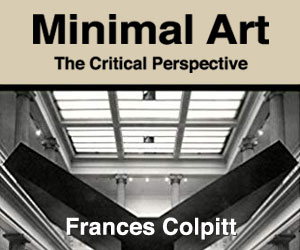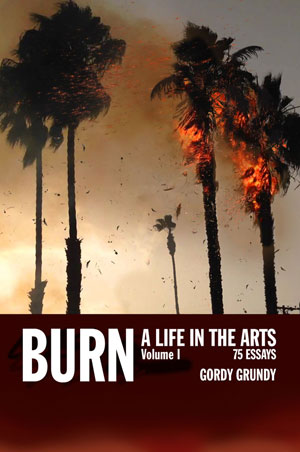
The Confession of Sweetwater: Who Destroyed Ed Ruscha’s Masterpiece?
Part One
by Gordy Grundy
This is huge. I was grinding pencil lead and burning paper as I furiously wrote down her confession. “I painted over Ed Ruscha’s Sweetwater with thick blue enamel...” The perp was speaking softly, her voice dulled with regret. An art world mystery of over half a century has been solved and I have the confession!
Walking the art beat, sensational stories do not avail themselves. You have to dig deep or get lucky. It’s hard to make a story out of the minimalist who gets decorative or a video artist who suddenly sculpts. Conversely, politics won’t let you write about the trustee’s wife who ran off with the street artist. This time I got lucky. I had a genuine, old-school scoop.
I wrote a piece for Artillery magazine about the impact of gallerist Irving Blum. In the interview, I asked, “What happened to Ed Ruscha’s seminal painting Sweetwater? Is it true that a UCLA art student painted over it?” Blum had no answer. And neither did the art world. The only reference to the incident is an oral history by academic Henry Hopkins. He identifies the event, but not the perpetrator, “a name I’ve fortunately forgotten.” Who destroyed the Ruscha? What twisted mind would eliminate such a very important, avant-garde work?
My article, “Ho Hum Blum,” received much attention and critical praise. Several weeks later, a letter, addressed to me, arrived at the Artillery headquarters. It was signed Olga Seem and she confessed to the crime. The true story, known only to a few, has come to the fore after half a century. As a result, many books, essays and a catalogue raisonné will need to be corrected. The Ruscha history has been rewritten.

As the notion of American pop art was beginning to form in the minds of a small handful of artists, the Los Angeles painter began a series of text-based works, the likes of which had no precedent. These minimal abstract pieces had elements that were both loose and tight, messy and precise. Today, many write that the most influential and seminal of these works are SU (1958), Box Smashed Flat commonly known as “Vicksburg” (1961) and Sweetwater (1959). All feature ink and oil on canvas. Red and blue striped fabric was applied to SU.
Henry Hopkins (1928-1988) was a respected curator and educator. He describes Sweetwater in his oral history for the Archives of American Art at the Smithsonian:
“It was an interesting configuration because, again, it was essentially a white canvas of rather large scale. At the bottom the word “Sweetwater” was spelled across the base in typographical form with two very fine lines, one above the word and one below the word. Then, the full bottom half of the canvas, other than that, was completely blank. In the top section it had a series of splotches of color where he had obviously put a pile of paint on and dragged across the surface, maybe with a wooden stick or a piece of cardboard or who knows... It’s a very funny painting. The top is very rich in pigment, and like an Abstract Expressionist painting, the bottom half is pure and clean, with the one word, “Sweetwater.” (Ruscha and I) talked a little bit about that. I wanted to know what “Sweetwater” meant. Sweetwater is a town in Texas along Route 66.”
In 2009, Christopher Knight wrote an article in the Los Angeles Times on the unsolved Sweetwater mystery and wisely noted that there is a comma at the end of the “Sweetwater” text, a continuation with an eye on a future horizon, like a road.
Candy Coleman, a director of the Gagosian Gallery, corrected the history for me, “Sweetwater is a small Tennessee town that Ruscha hitchhiked through in 1954 when he was 17. His perception of the sprawling American landscape, viewed from the road, continues to surface in his artwork today.” She continues, “This work has special meaning for me since I grew up not far from Sweetwater, TN. When I first began working with Ed in 1996, I learned about this painting’s demise and was fascinated. The demise of this painting is one of the reasons I began the catalogue raisonne of Ed’s paintings.”

The only remaining evidence of Sweetwater are two black-and-white photographs of the colorful painting. Hopkins says, “The recollection clearly is that they were rather pastel-like shades. I vaguely remember cerulean blue, ochre and a green, just simply dragged across the canvas in a very thick, impasto way.”

How important is Sweetwater? Candy Coleman answers, “Sweetwater was one of Ruscha’s first paintings, incorporating text combined with strong imagery.” Most notably, it was one of Ruscha’s first large works. I asked Coleman what Sweetwater would bring on the open market today. She replied, “Since I worked at Sotheby’s for 10 years I am comfortable guessing that the auctions would estimate this work at $4 to 6 million, but it is very hard to predict what it would sell for, considering the interest in Ed’s early works.”
Hunter Drohojowska-Philp, the author of Rebels in Paradise: The Los Angeles Art Scene and the 1960s, states, “Since Sweetwater is considered “Ed’s first major painting,” in the words of its owner Henry Hopkins, its potential value is incalculable. However, Ruscha is a great artist so he simply went on to make a second major painting, and then a third and so on.”
Sweetwater was not destroyed by malice, envy or idealism. Sweetwater was destroyed with the same values with which the original artwork was created: an artist finding a new voice. This was not an art crime. This is a tragedy of opportunity and hope...
For The Confession of Sweetwater: Who Destroyed Ed Ruscha’s Masterpiece? Part Two, Click Here.

———————————————————————
GORDY GRUNDY is a Los Angeles based artist and arts writer. His visual and literary work can be found at www.GordyGrundy.com
Back to Main Page
|
|














|